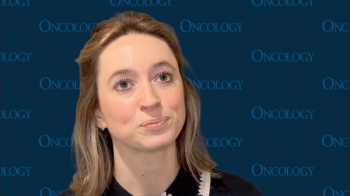
Treatment Experience for a Patient With GVHD
A patient with GVHD chronicles his treatment experience, and GVHD experts share thoughts on how to approach treatment.
Episodes in this series

Transcript:
Preet M. Chaudhary, MD, PhD: Hector, can you tell us what your overall treatment experience was in this journey?
Hector Cuevas: Really hard, it’s been hard. It was hard, everything has been hard.
Preet M. Chaudhary, MD, PhD: Now at least you don’t have GVHD [graft-vs-host disease].
Hector Cuevas: I’m a lot better now. I feel better, and hopefully, it’s all on the up.
Preet M. Chaudhary, MD, PhD: Your underlying disease, leukemia, is under control as well?
Hector Cuevas: Yes.
Preet M. Chaudhary, MD, PhD: In your case, after the GVHD prophylaxis was stopped, you just presented with lung GVHD, but it was caught early by Dr Tam and his team, and he started you back on steroids, and Jakafi [ruxolitinib]. And now all the symptoms are completely gone?
Hector Cuevas: Yes.
Preet M. Chaudhary, MD, PhD: Wonderful.
Eric Leon Tam, MD: Hector did very well with high-dose steroids initially. We tried ruxolitinib, and he was already off tacrolimus, so we restarted tacrolimus for him. We tried ruxolitinib, but he didn’t tolerate it too well, he had some GI [gastrointestinal] adverse effects, and his blood counts dropped from it. But luckily, he was already improving, and within 1 to 2 months he was off of oxygen, and now he’s off steroids, and we’re working our way down with the tacrolimus.
Lakshmi Savitala-Damerla, PA-C: I remember when he came in and how sick he was. He had a nasal cannula, and was walking with a cane because he was feeling very weak, and to see him do well and be a part of this discussion is heartwarming and so satisfying.
Preet M. Chaudhary, MD, PhD: I have seen that too. The key to success in the care of these patients is to start early, and in his case, we started steroids, we started Jakafi early. I’ve seen in other patients too that gut GVHD is very difficult to control once it gets activated, especially in the older days when we were treating it with just steroids alone. Now, with the early addition of Jakafi, I have seen these patients responding much better compared to in the past, so that is a key change in the treatment landscape for GVHD. Now we have agents that are much more targeted and are generally better tolerated than steroids, and I think the key here is to initiate them early if the patients are not responding to the first-line therapy.
Lakshmi Savitala-Damerla, PA-C: For me, for the GI GVHD, budesonide is a wonderful steroid, but it’s a topical steroid. You can keep the patients on it for longer periods of time and not have to worry about the true systemic steroid consequences. Instead of putting patients through a biopsy, which is very unpleasant—I know it’s the gold standard to do a biopsy and have that information, but my point is, why not try budesonide? If they’re already improving, you can at least not put a patient through biopsies if you don’t have to.
Preet M. Chaudhary, MD, PhD: The way I look at it is that you can put them on budesonide, which acts locally, but with GVHD, there’s a systemic component to it. So always keep that in mind, to make sure we use that in combination with other agents that are available to us and have a more additive effect, and to cover all the organs.
Thank you, Hector, Dr Tam, and Lakshmi for joining us in this discussion of GVHD brought to you by the CancerNetwork®, and thank you to our viewing audience. We hope you found this interactive discussion to be informative and beneficial to your clinical practice.
Transcript edited for clarity.
Newsletter
Stay up to date on recent advances in the multidisciplinary approach to cancer.
























































































